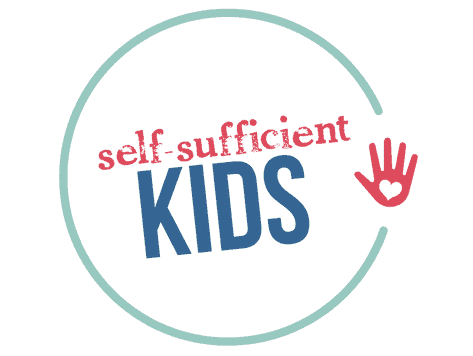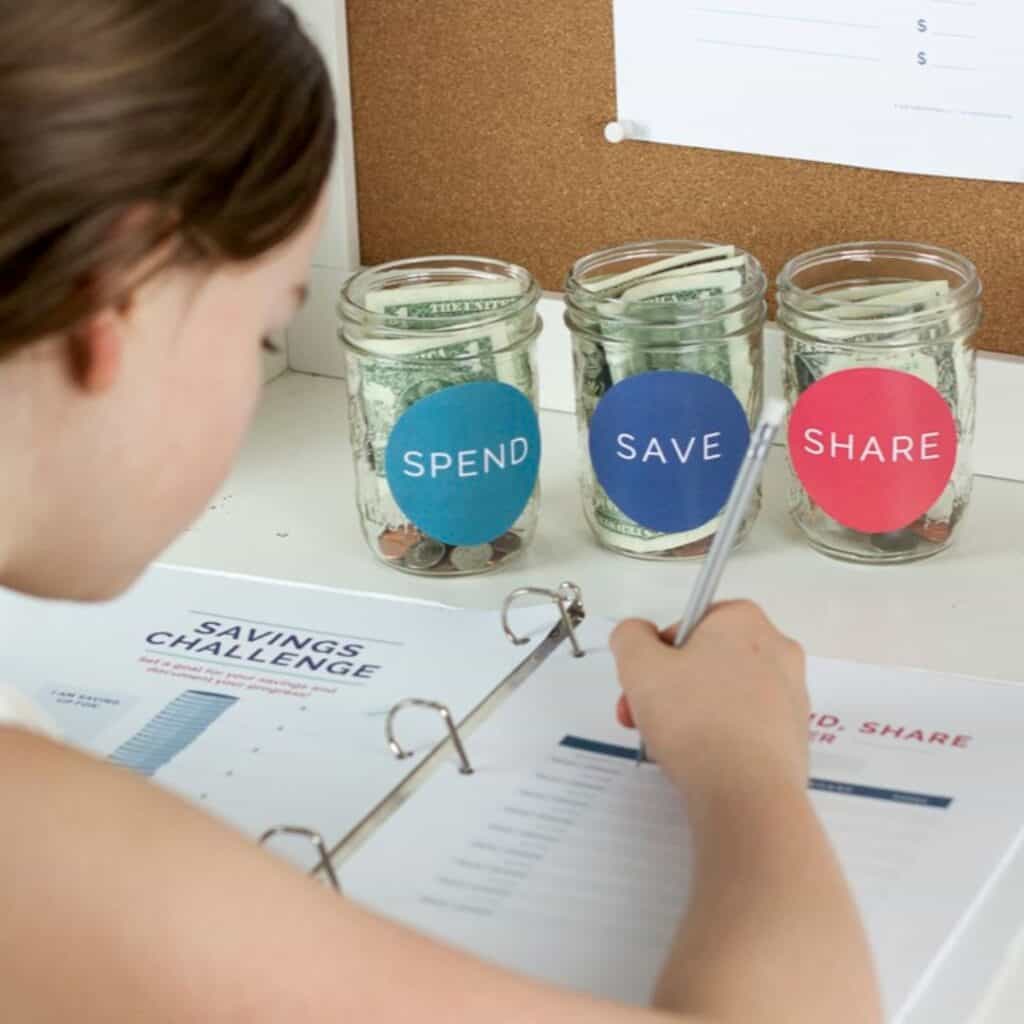6 of the Best (& Fun!) Counting Money Games for Kids
The first step in kids financial literacy is to learn how to distinguish and count money. The following counting money games can help kids master key concepts in counting coins and bills.
See 12 of The Best Money Games for Kids for more ways to teach kids about money.

(This post contains affiliate links. If you click on a link and purchase the item, I will receive a commission at no extra cost to you.)
“I have 108!” my then six-year-old daughter exclaimed with pride while sitting on her bedroom floor.
She was referring to the pennies that were in front of her. The amount sounded enormous in her young mind. But she didn’t realize that one hundred and eight pennies wouldn’t purchase much.
After congratulating her, I suggested swapping 100 of her pennies for a dollar bill. But she wouldn’t have it.
Clearly, she was thinking: “Why would I want one piece of paper when I can have 100 shiny copper coins?”
Thankfully now at 9-years-old, my daughter has a better grasp of coins, bills, and their corresponding values. And recently she giggled when I told her this story.
In a world where adults use online banking and credit cards, kids have little exposure to real money. And therefore, it can be difficult for them to easily learn the value of coins and bills, let alone distinguish between them.
That’s where games can help. Since there are few opportunities for kids to see and use coins and bills in the real world, games can be a great educational tool. Plus they’re fun.
The following counting money games are designed to help kids better understand the values of coins and bills. Included below are card and board games plus two apps that kids can use to practice on the go.
The Best Counting Money Games: Card and Board Games
The following counting money games are arranged according to kids’ understanding of counting coins and bills. The first few games are best for beginners while subsequent games help kids practice their knowledge.
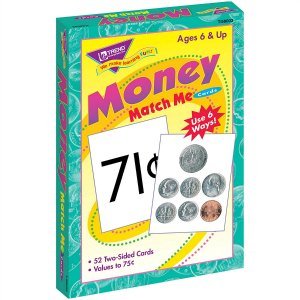
Money Match Me
Skills Focus: Learning to identify and count coins
Age range: 6 to 8
While not entirely a game, Money Match Me can be a fun way for kids to test their knowledge of American coins. One card shows a group of coins that need to be matched with both a numeric and written description. For example, a picture of three quarters would be matched with a card that says both 75¢ and “Seventy-five cents”. These cards can be a great way to introduce coins to children. Further skills of adding and subtracting and making change can be acquired with some of the other games listed below.
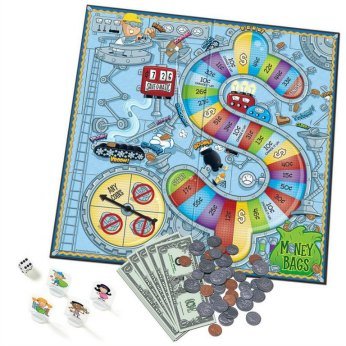
Money Bags Game
Skills Focus: Distinguishing different bills and coins and counting money
Age range: Recommended for ages 7+
If your kids need practice counting money and distinguishing between different coins and exchanging coins, the Money Bags game can help. As players move along the board they collect money from the bank but are constrained to specific coins. The game ends when the first player has moved through the spaces and reaches the last “End” space. The winner is the person who has the most money. While dollar bills are used in this game, the primary focus is on coins.
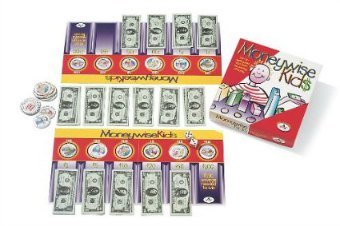
Moneywise Kids
Skill focus: Adding and subtracting U.S. bills
Age range: ages 7-12
If your child has basic money and math skills but could use a bit more practice handling bills, Moneywise Kids could be a great game to play. The objective of Moneywise Kids (which is actually two games in one), is to let children experience what it’s like to handle money, make change, and practice spending and saving money. In the first game, players race to see who can reach $100 in savings first. A bit of complexity is added to the second game since in addition to collecting $100, players also have to collect six Moneywise Markers which include paying for medical expenses, transportation, housing, taxes, clothing, and food. Since the focus is on adding and subtracting with different denominations of bills, this game is solidly educational, but thankfully also fun for kids to play.
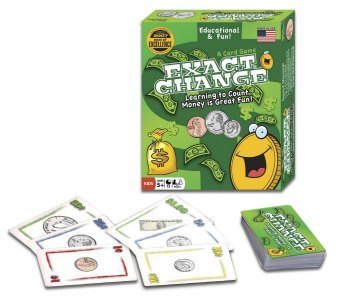
Exact Change
Skill focus: Distinguishing between U.S. coins and bills
Age range: Recommended for ages 6 and up
Think of Exact Change as nearly identical to the game Uno except coins and bill take the place of numbers. There’s also one twist: a few of the cards have quantities such as $1.20. If such a card is played, the next player can put down multiple cards that add up to $1.20 or simply play a card of the same color. While this game is fun, kids aren’t forced to really think through or calculate coins and bills as they are in other money games. This is a fun way to reinforce kids’ knowledge of money but not the best game for a beginner to counting coins and bills.
The Best Counting Money Games: Apps
Apps provide another opportunity for kids to learn how to count coins and bills. Plus, they’re interactive and kids can play with them independently.
While there are numerous apps that provide counting money games, the two listed below are really all you need. Not only do these apps teach kids how to count coins but they have the added benefit of being free.
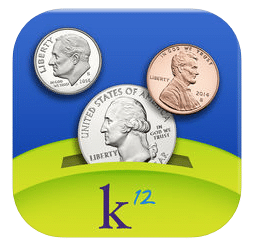
Counting Coins
Skill focus: Distinguishing and counting U.S. coins
Age range: Recommended for ages 4 and up
Counting Coins is a simple app that helps kids practice working with U.S. pennies, nickels, dimes, and quarters. There are four ways to play: 1) Match the value: try to make the same value as the coins shown on the screen using a different combination of coins, 2) Make the total: use the correct coins to make the total shown, 3) How many cents?: Type in the value of the coins shown, and 4) Show values: this feature tells kids the values of one or a combination of coins. This is the perfect app to introduce the concept of coins to kids. Be sure to also check out the follow-up app: Counting Bills and Coins.
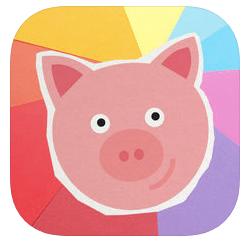
Peter Pig’s Money Counter
Skill focus: Distinguishing, counting, and adding U.S. coins
Age range: Recommended for ages 5 through 8
Peter Pig’s Money Counter allows kids to count and sort coins in three different games. Users can choose their skill level and whether or not they want to win rewards along the way. In the first game, kids place coins in the jar with the correct sign such as 25¢, 10¢, 5¢ and 1¢. In the second game, kids count a selection of coins and the press a circle with the correct amount. The third game has kids count from two groups of coins and then decide which amount is greater. These games are all fun ways to learn how to count although children might need help at first to figure out what they’re supposed to do in each game.
The Kids Money Management Toolkit has everything you need (except money!) to begin giving your kids an allowance. In addition to guidance and advice, you’ll also receive Save, Spend, and Share jar labels, a Kids Money Ledger, a Savings Challenge Sheet, a Jobs-for-Hire Sheet, and a Kids Allowance Contract. Click here to learn more.
You may also like:
28 of the Best Children’s Books About Money
19 Fun Counting Games and Activities for Kids
Kids Won’t Really Understand Money Until You Do This
Teach Kids the Value and Meaning of Money With This Game
About the Author

Kerry Flatley is the owner and author of Self-Sufficient Kids. She has a BA in economics, an MBA, a certificate in financial planning, and has been investing ever since she landed her first job. Kerry also has two girls, ages 12 and 14, who have been receiving allowance – and learning money management – for the past six years.
